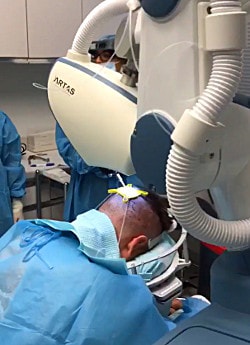May 26th, 2017
Q: What is the difference between the ARTAS 9x and the earlier versions of the robot? — T.J. ~ Washington, D.C.
A: The differences can be grouped into four broad categories:
1. Speed: The 9x is 20% faster than the 8x. This is achieved through the ARTAS robot’s ability to more quickly and accurately align with the follicles, faster movement from follicular unit to follicular unit while harvesting, and a shortened dissection cycle (less than 2 seconds). In addition, the 9x uses white LED lights instead of red, which permits an increased work flow from the ability to simultaneously incise and extractions grafts. The decreased strain on the eyes from the white lights (compared to red) makes this possible.
2. Accuracy: The 9x uses smaller needles that minimize wounding and donor scarring. It is especially useful for patients with fine hair or those who want to keep their hair short.
3. Functionality: The robotic arm on the 9x has a 1-inch base extender that gives the machine a longer reach and decreases the need for the patient to be repositioned. The ARTS 9x also has a smaller robotic head allowing the robot to harvest the grafts at a more acute angle. The ARTAS 9x also allows for more site making options due to the universal blade holder and the ability to program a change in the orientation of the incision in different regions of the scalp. The ARTAS 9x also uses a new harvesting halo to secure the tensioner (the grid-like device that indicates where the robot should harvest) which is faster to apply and more comfortable for the patient.
4. Use of Artificial Intelligence: The technology notifies the physician early-on if the harvesting is not precise, so that action can be taken to ensure most effective results. The ARTAS software can now detect areas with low (or no) hair density and prevent those areas from being over-harvested. This also decreases human error and saves time by automatically blocking these areas with low density. Finally, the ARTAS Hair Studio, can now create a 3-D image of the patient’s head with only one photo (as opposed to the prior requirement of 3 to 5).


 Robert M. Bernstein, MD, MBA, FAAD has been recognized by his peers with inclusion in his eighteenth consecutive edition of New York Magazine’s annual ‘Best Doctors in New York’ issue. Dr. Bernstein helped re-invent hair transplant surgery by pioneering the Follicular Unit Transplantation (FUT) procedure and by becoming an early proponent of robotic hair transplant surgery (Robotic FUE). He is the only hair restoration surgeon named to the prestigious “Best Doctors” list for as many years. Of being included in the 2017 issue, he said: “New York has some of the finest doctors in the world, so to be considered among the best by my peers is quite an honor. It is equally satisfying when a patient tells us that we helped change their life.”
Robert M. Bernstein, MD, MBA, FAAD has been recognized by his peers with inclusion in his eighteenth consecutive edition of New York Magazine’s annual ‘Best Doctors in New York’ issue. Dr. Bernstein helped re-invent hair transplant surgery by pioneering the Follicular Unit Transplantation (FUT) procedure and by becoming an early proponent of robotic hair transplant surgery (Robotic FUE). He is the only hair restoration surgeon named to the prestigious “Best Doctors” list for as many years. Of being included in the 2017 issue, he said: “New York has some of the finest doctors in the world, so to be considered among the best by my peers is quite an honor. It is equally satisfying when a patient tells us that we helped change their life.” In April 2017, Bernstein Medical became the first hair restoration practice to perform robotic hair transplant surgery using the new ARTAS Robotic System 9x. ARTAS 9x is a major upgrade of the hair transplant robot, enabling faster and more precise Robotic FUE procedures. Some of the hardware improvements to the system include a white light LED, color camera and tensioner, 20-gauge harvesting needle, robotic base extender, new needle mechanism cover, and more comfortable headrest and halo. Software upgrades include better scar detection, faster harvesting, ability to zoom in to the main viewing screen, and improved ARTAS Hair Studio software.
In April 2017, Bernstein Medical became the first hair restoration practice to perform robotic hair transplant surgery using the new ARTAS Robotic System 9x. ARTAS 9x is a major upgrade of the hair transplant robot, enabling faster and more precise Robotic FUE procedures. Some of the hardware improvements to the system include a white light LED, color camera and tensioner, 20-gauge harvesting needle, robotic base extender, new needle mechanism cover, and more comfortable headrest and halo. Software upgrades include better scar detection, faster harvesting, ability to zoom in to the main viewing screen, and improved ARTAS Hair Studio software.  Dr. Bernstein closed the 2017 ARTAS Users Meeting with a discussion of five advanced techniques in robotic hair transplant procedures that he developed at Bernstein Medical. His presentation covered the benefits of pre-making recipient sites, long-hair FUE, tensioner placement, feathering edges in harvesting, and robotic graft selection. The “Hair Restoration Pearls” presentation included case studies, photographs, and videos demonstrating the techniques to the audience of hair restoration physicians. The two-day affair; which was held in Coronado, California; was a huge success, with over 260 attendees from around the world representing 204 robotic hair restoration practices.
Dr. Bernstein closed the 2017 ARTAS Users Meeting with a discussion of five advanced techniques in robotic hair transplant procedures that he developed at Bernstein Medical. His presentation covered the benefits of pre-making recipient sites, long-hair FUE, tensioner placement, feathering edges in harvesting, and robotic graft selection. The “Hair Restoration Pearls” presentation included case studies, photographs, and videos demonstrating the techniques to the audience of hair restoration physicians. The two-day affair; which was held in Coronado, California; was a huge success, with over 260 attendees from around the world representing 204 robotic hair restoration practices.


